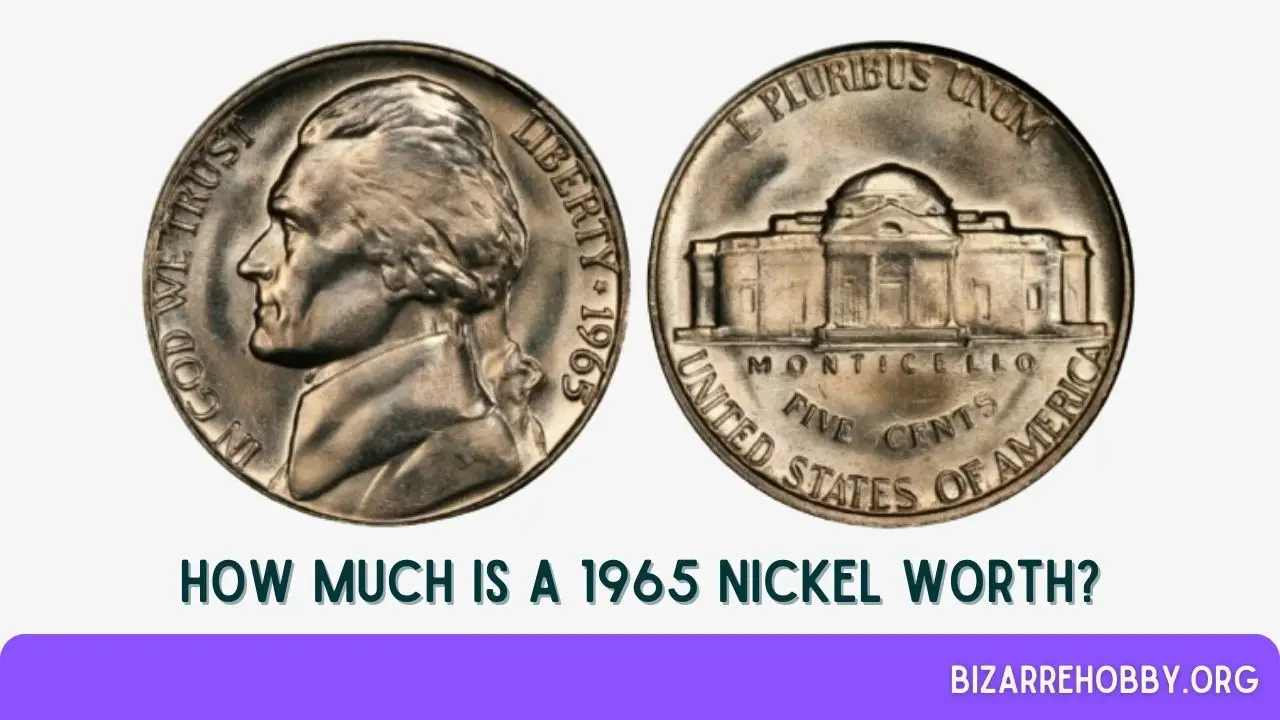The Jefferson nickels minted in the 1960s, including the 1965 edition, can vary significantly in value. But what makes a high-quality coin stand out?
In this article, we’ll delve into the specifics of the 1965 nickel value, examining what distinguishes a common coin from a rare and valuable one. We’ll also explore the history and design of the Jefferson nickel.
Ready to learn more? Let’s dive in!
Table of Contents
Value Chart for 1965 Nickel
| Mint Mark | XF45 | MS60 | MS65 | MS67 |
|---|---|---|---|---|
| 1965 No Mint Mark Nickel Value | $0.05 | $1 | $15 Full step: $10,000 | $2,000 |
| SP60 | SP65 | SP67 | SP69 | |
| 1965 No Mint Mark Special Strike Nickel Value | $3 Cameo: $4 | $10 Cameo: $18 Deep cameo: $425 | $26 Cameo: $210 Deep cameo: $3,500 | $700+ |
Historical Significance of the 1965 Nickel
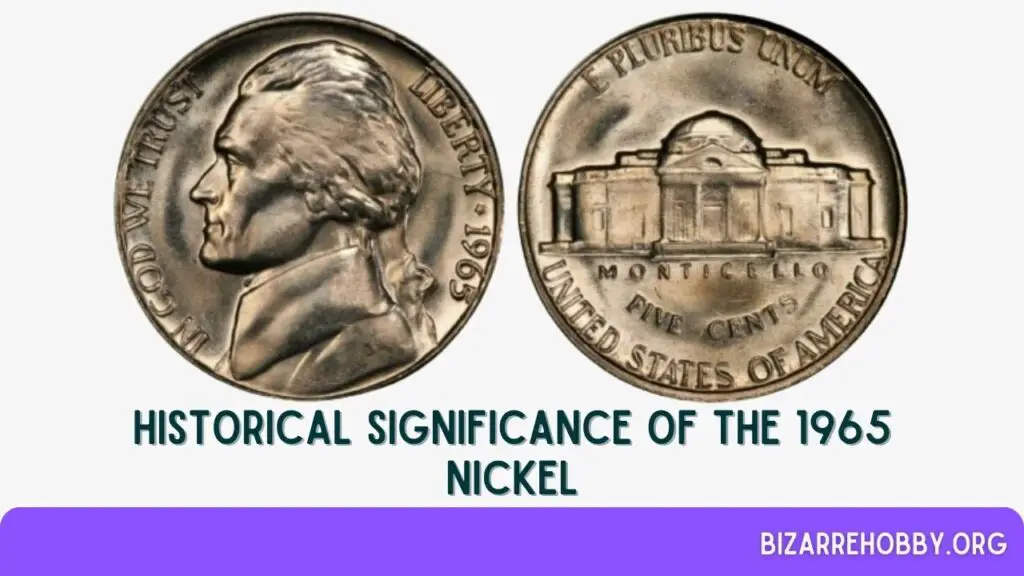
The year 1965 is notable for coin collectors as it marks the beginning of the “modern original design” Jefferson nickel series.
While earlier nickels are often referred to as “vintage,” the primary difference is the date when the Treasury ceased using silver in dimes, quarters, and half dollars.
The 1965 nickel retains the same design as the original Jefferson nickels first minted in 1938. These coins are named after the obverse, which features a portrait of Thomas Jefferson, the third President of the United States.
The Jefferson nickel replaced the Buffalo nickel, which was retired after 25 years due to difficulties in striking the coin. The new design was created by Felix Schlag, a German-born sculptor who emigrated to the USA in 1929.
Initially, Schlag’s signature was absent from the coins, but in 1966, the US Mint added his initials to the obverse, beneath Jefferson’s portrait. This remained until 2005, when the design was updated to a three-quarters profile of Jefferson.
In 1965, all nickels were produced at the Philadelphia Mint, which did not use mint marks at the time. There were no proof nickels that year, but special strikes were available in Special Mint Sets, also produced in Philadelphia.
Jefferson nickels continue to be minted today, with the current portrait designed by Jamie Franki.
Design of the 1965 Nickel
By understanding the designs and details, collectors can better appreciate the value and history of the 1965 Jefferson nickel.
Obverse Design of 1965 Nickel
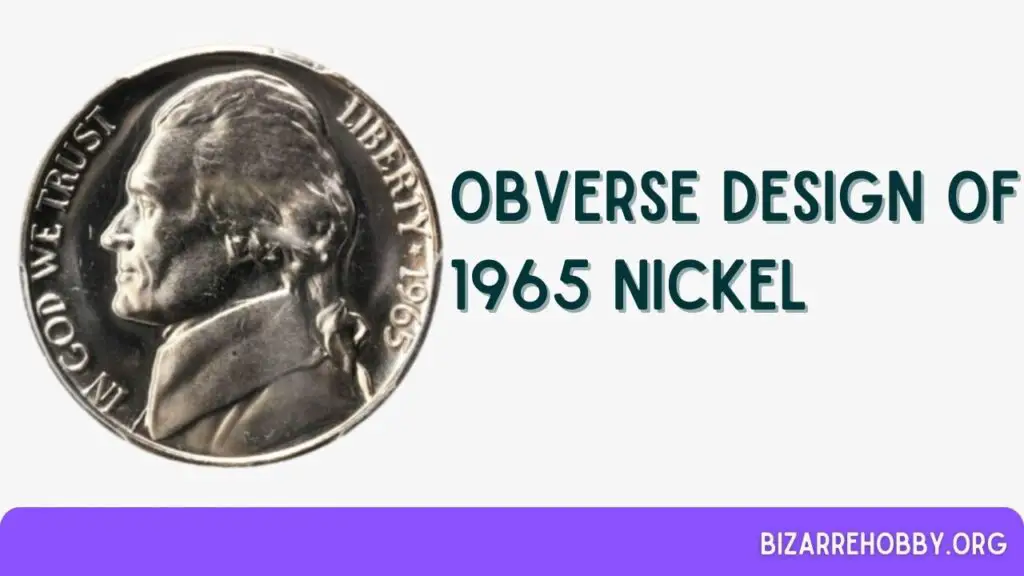
The obverse, or “heads” side, of the 1965 nickel features a profile portrait of Thomas Jefferson, designed by Felix Schlag. Jefferson, a Founding Father and the third President of the USA, is depicted facing left with a slight smile.
The design is reminiscent of a bust by French artist Jean-Antoine Houdon, which can be viewed at the Boston Museum of Fine Arts. The motto “IN GOD WE TRUST” is inscribed to the left of the portrait, curving along the coin’s edge. To the right, you’ll find the word “LIBERTY” and the date.
No mint marks are present on the 1965 nickels, as they were all struck at the Philadelphia Mint, which did not use mint marks until the late 1970s.
Reverse Design of 1965 Nickel
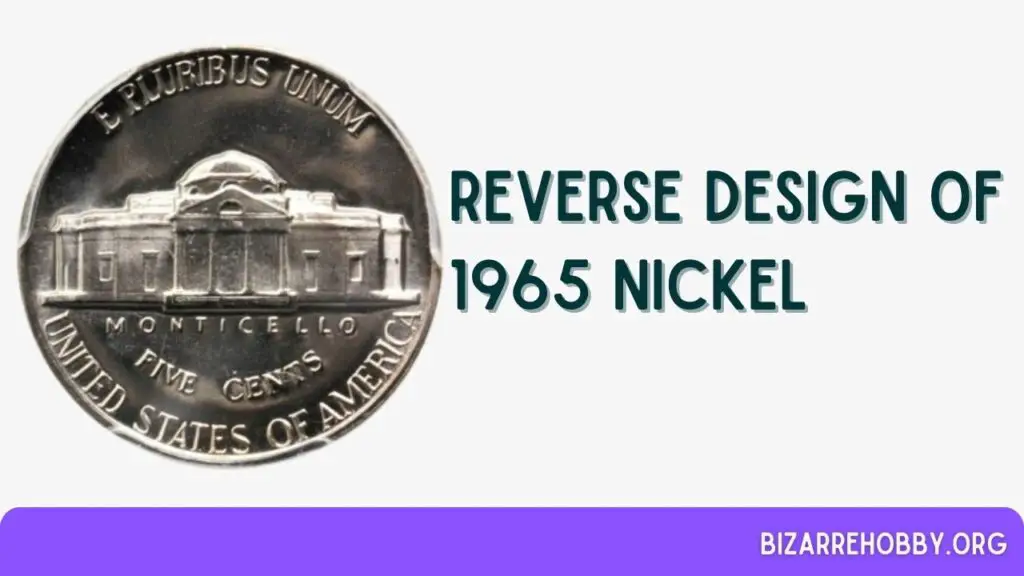
The reverse side, also designed by Felix Schlag, features Monticello, Jefferson’s Virginia estate. Unlike Schlag’s original competition-winning design, which showed Monticello from a three-quarters angle with a tree, the final design presents a frontal view of the building.
Mint officials at the time preferred a more traditional look and required changes to the font and design elements. The inscriptions include “E PLURIBUS UNUM” at the top, “MONTICELLO” below the image, and “FIVE CENTS” and “UNITED STATES OF AMERICA” at the bottom.
Technical Specifications of 1965 Nickel
The 1965 business strike nickels, intended for everyday use, come in two variants. Most coins lack clear lines separating the five steps in front of Monticello. Those with distinct steps are known as “full step” nickels and are rarer, thus commanding higher prices.
Despite being called nickels, Jefferson nickels are primarily made of copper, with only 25% nickel, giving them their silver color. Each coin measures 21.2 millimeters in diameter, weighs 5 grams, and has a plain edge.
Grading Guide for 1965 Nickel
Understanding the grading of your 1965 nickel is crucial to determining its value. Here’s a quick reference guide to the grading scale:
| Sheldon Scale | Grade |
|---|---|
| 1 | Basal State-1 |
| 2 | Fair |
| 3 | Very Fair |
| 4, 5, 6 | Good |
| 7, 8, 10 | Very Good |
| 12, 15 | Fine |
| 20, 30 | Very Fine |
| 40 | Extremely Fine |
| 50 | About Uncirculated |
| 60 | Mint State |
| 65 | Mint State |
| 70 | Mint State |
For a detailed understanding of each grade, please refer to our comprehensive grading guide for Jefferson Nickel. Knowing the exact grade of your coin is essential for accurately assessing its value.
1965 Nickel Value Guides
The value of a 1965 nickel can vary significantly based on its condition, mint errors, and whether it has any special designations. Below, we explore the different aspects that influence the value of these coins.
1965 No Mint Mark Nickel Value
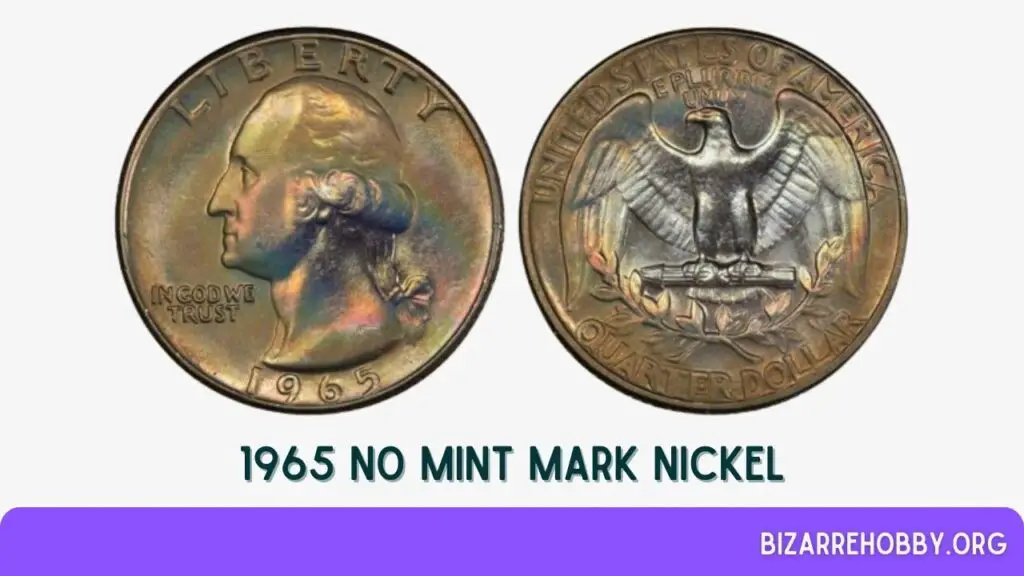
In 1965, the Philadelphia Mint was the sole producer of nickels, striking over 136 million coins intended for everyday transactions. These “business strike” nickels are common in circulated condition and typically hold a value close to their face value unless they exhibit unique mint errors.
For collectors seeking higher quality coins, the challenge lies in finding those with a “full step” designation, indicating a well-defined strike. The Professional Coin Grading Service (PCGS) estimates that only about 1,000 such coins exist.
The coin grading scale ranges from 1 to 70, with 1 being the lowest grade where the coin is still identifiable, and 70 representing a perfect coin. Coins graded 60 and above are considered “mint state” and show no signs of circulation.
- MS60: A standard 1965 nickel in this grade is valued at approximately $1.
- MS65: At this grade, the coin is considered to be in “gem” condition and can be worth around $15.
- MS67: The most valuable standard 1965 nickels, with only nine certified by the PCGS, are valued at $2,000 each.
For those interested in full step nickels, the rarity increases:
- MS63: Valued at $250.
- MS64: Worth $2,000.
- MS65: The sole example is valued at $10,000.
- MS66: The highest grade, with two coins valued at $40,000 each.
1965 No Mint Mark Special Strike Nickel Value
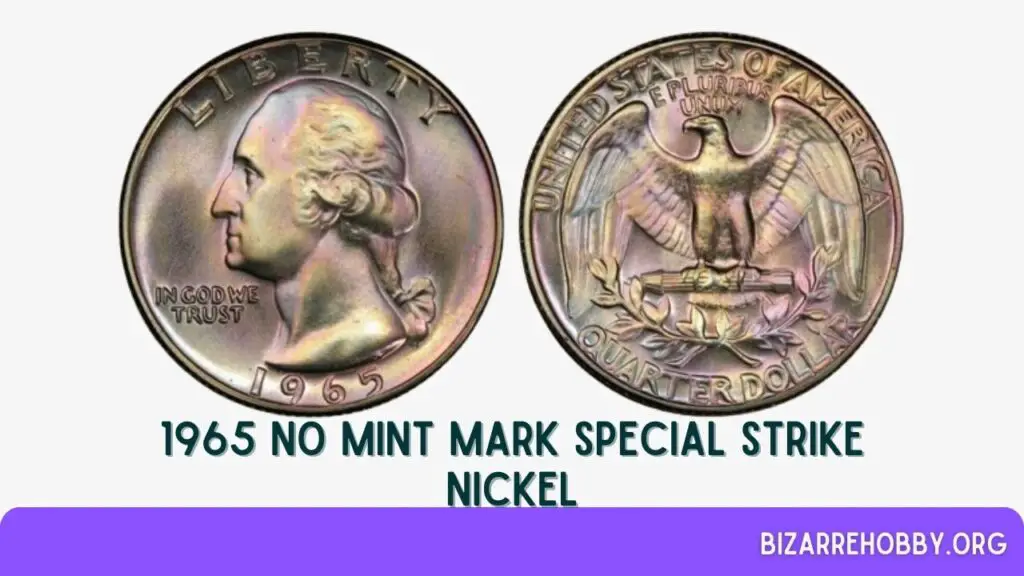
In 1965, no proof nickels were produced. Instead, collectors could purchase “special strike” coins, which were of higher quality than business strikes but not as refined as proofs. These coins were included in Special Mint Sets alongside other denominations from the same year.
Special strike nickels are graded with the prefix “SP”:
- SP60: Valued at around $3.
- SP65: Worth approximately $10.
- SP67: Valued at about $26.
Coins with “cameo” or “deep cameo” designations, which feature a striking contrast between polished fields and frosted devices, are more valuable:
- Cameo SP60: Valued at $4.
- Cameo SP65: Worth $18.
- Cameo SP67: Valued at $210.
- Deep Cameo SP63: Valued at $100.
- Deep Cameo SP65: Worth $425.
- Deep Cameo SP67: The highest grade, valued at $3,500, with 16 coins certified at this level.
By understanding these nuances, collectors can better assess the value of their 1965 nickels and make informed decisions about buying, selling, or holding onto these coins.
Rare 1965 Nickel Error List
Errors in coin production can significantly enhance the value of a coin, making them highly sought after by collectors. The 1965 nickel is no exception, with several notable errors that can fetch impressive prices at auction.
Below, we explore some of the rarest and most valuable errors found in 1965 nickels.
1965 [P] No Mint Mark Nickel, Fold-over Strike error
A foldover strike error occurs when the planchet (the blank piece of metal that becomes a coin) is struck on its edge, causing it to fold over. This type of error results in a coin with an irregular shape and often missing parts of the design.
One such 1965 nickel exhibited this error, leading to a distorted appearance where the word “America” on the reverse side was unrecognizable. This coin was graded MS64 by the Numismatic Guaranty Corporation (NGC). Its unique error made it highly valuable, selling for $4,300 at auction.
1965 Nickel, Struck on Clad 10-cent Planchet error
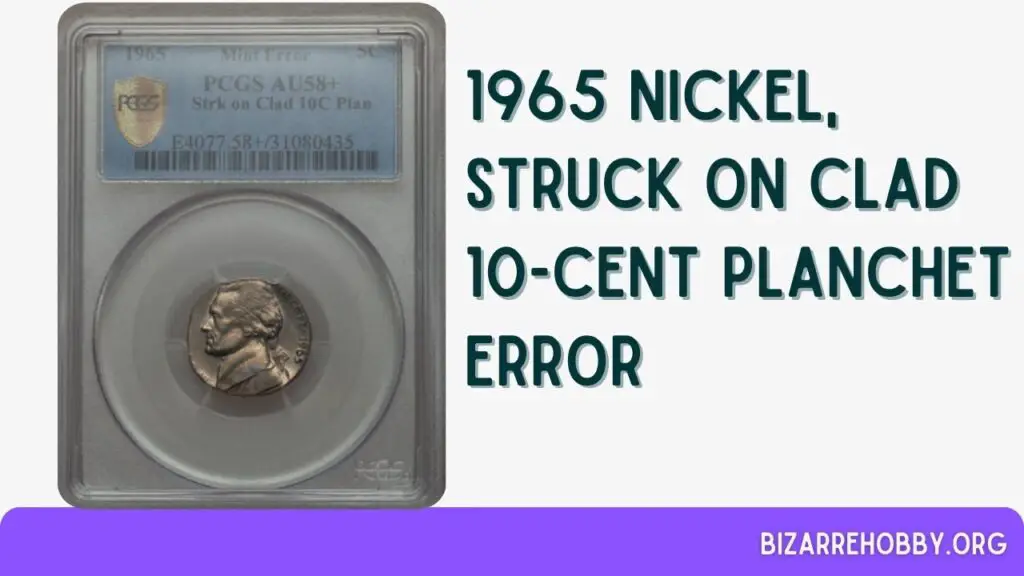
Occasionally, coins are mistakenly struck on planchets intended for a different denomination. This happened with a 1965 nickel that was struck on a planchet meant for a dime. The smaller surface area of the dime planchet caused the top of Jefferson’s head to be positioned at the very edge of the obverse side.
This error coin was certified by the Professional Coin Grading Service (PCGS) and graded AU58+ (About Uncirculated). When it went to auction, it fetched a price of $325, reflecting its rarity and the interest it generated among collectors.
Where to Sell Your 1965 Nickel?
Knowing the value of your 1965 nickel is just the first step. If you’re looking to sell, there are several reputable online platforms where you can do so easily. Each platform has its own advantages and disadvantages, so it’s important to choose the one that best suits your needs.
What to look for in the 1965 Nickel?
FAQs on 1965 Nickel Value
How much is a 1965 nickel worth today?
Most 1965 nickels found in circulation show signs of wear and are typically worth only their face value. However, coins in excellent condition or those with interesting Mint errors can be worth significantly more. The finest examples can fetch thousands of dollars. A good indicator of a coin’s quality is the clarity of the steps in front of Monticello on the reverse side. If all five steps are clearly separated, your nickel could be highly collectible.
How much is a 1965 nickel with no mint mark worth?
The absence of a mint mark does not affect the value of a 1965 nickel. Both business strikes and special strikes from 1965 lack mint marks because they were all produced at the Philadelphia Mint, which did not use mint marks at that time.
Is a 1965 nickel real silver?
Despite its silver appearance, the 1965 nickel is not made of silver. It consists of 75% copper and 25% nickel. The silver color is due to the nickel content.
Final thoughts
The 1965 nickel is a fascinating coin for collectors, offering a range of values depending on its condition, errors, and special designations. Whether you’re a seasoned numismatist or a casual collector, understanding what to look for can help you identify valuable coins and make informed decisions.
From the common business strikes to the rare full step and error coins, each 1965 nickel has its own story and potential worth.
